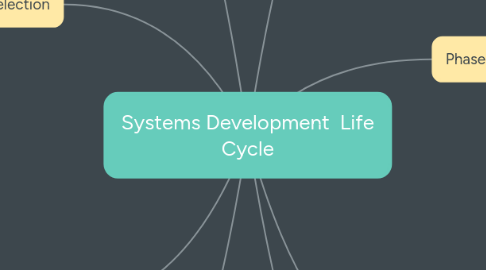
1. Phase VI- Application Programming and Testing
1.1. Applying Programming Language
1.1.1. Java
1.1.2. C++
1.1.3. .NET.
1.2. Testing the Application Software
1.2.1. Testing Methodology
1.2.2. Testing Offline Before Deploying Online
1.2.3. Test Data
2. Phase IV- System Evaluation and Selection
2.1. Detailed Feasibility Study
2.1.1. Technical Feasibility
2.1.2. Economic Feasibility
2.1.3. Legal Feasibility
2.1.4. Operational Feasibility
2.1.5. Schedule Feasibility
2.2. Cost-benefit Analysis
2.2.1. Identify costs
2.2.1.1. One-time Costs
2.2.1.2. Recurring Costs
2.2.2. Identify Benefits
2.2.2.1. Tangible Benefits
2.2.2.2. Intangible Benefits
2.2.3. Compare Costs and Benefits
2.2.3.1. Net Present Value
2.2.3.2. Payback method
2.3. Systems Selection Report
3. Phase III- Conceptual Systems Design
3.1. Objective: To produce several alternative conceptual systems that satisfy the system requirements identified during systems analysis.
3.2. 2 Types of Approaches
3.2.1. Object-Oriented Approach
3.2.2. Structured Design Approach
3.2.2.1. Data flow diagram (DFDs) and Structure Diagram depicts a top-down approach (from big picture into smaller details)
4. Phase II- Systems Analysis
4.1. System survey: The determination of what elements of the current system should be preserved as part of the new system
4.2. Gathering Facts
4.2.1. OBSERVATION
4.2.2. TASK PARTICIPATION
4.2.3. PERSONAL INTERVIEWS
4.2.4. REVIEWING KEY DOCUMENTS
4.3. The Analysis Step
4.4. System Analysis Report
5. Phase I - Systems Planning
5.1. Objective: Link individual system projects or applications to the strategic objectives of the firm.
5.2. Strategic Systems Planning: Allocates systems resources at the macro level & deals with a time frame of 3-5 years.
5.3. Project Planning: Allocate resources to individual applications within the framework of the strategic plan.
6. Phase VII- System Implementation
6.1. Testing the system
6.2. Documenting the system
6.2.1. Operator Documentation
6.2.2. User Documentation
6.2.3. User Handbook
6.2.4. Tutorials
6.2.5. Helpful Features
6.3. Converting the Database
6.3.1. 1. Validation
6.3.2. 2. Reconciliation
6.3.3. 3. Backup
6.4. Converting the New System
6.4.1. Cold Turkey Cutover
6.4.2. Phased Cutover
6.4.3. Parallel Operation Cutover
6.5. Post implementation Review
6.5.1. System Design Adequacy
6.5.2. Accuracy of Time, Cost, and Benefit Estimates
7. Phase VllI- Systems Maintenance
7.1. A formal process by which program changes can be managed to accommodate changes in user needs
7.2. Extensive Maintenance
7.3. Same treatment as new development
8. Phase V- Detailed Design
8.1. Objective: To produce a detailed description of the proposed system that both satisfies the system requirements identified during the system analysis and is in accordance with the conceptual design.
8.2. At the end of this phase
8.2.1. Perform a system design walkthrough
8.2.1.1. To simulate the operation of the system to uncover errors, omissions, and ambiguities in the design.
8.2.2. Review system documentation
